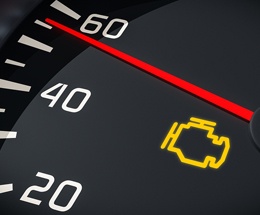
It’s happened to all of us at one time or another, whether we’re hurrying to work or on a family road trip. All of a sudden, a vehicle warning light turns on.
Depending on the light, it can bring instant panic. Thoughts of being stranded and what to do next can fill our heads. Hopefully, some help from roadside assistance can resolve serious issues. On the other hand, some lights can be a notification that something is working but not 100%. With winter approaching, now is an excellent time to become acquainted with some of these warning lights.
Warning lights and what they mean
If you see a light appear on your dashboard, don’t panic. Symbol lights can appear in different colors.
Red
Indicates a potentially serious problem or safety issue and should be taken to your dealer immediately.
Yellow/Orange
Something that needs to be serviced or repaired soon.
Green/Blue
indicates that your system is operating. You may see this color scheme when your headlights are on.
If a light is flashing, contact your local dealership or trusted mechanic.
1. Check Engine or Malfunction Indication Light.
There are many reasons that light may appear. Some of them are:
-
Your Oxygen (O2) sensor needs replacing;
-
Your gas cap is loose, damaged, or lost;
-
Your catalytic converter needs replacing;
-
Your mass airflow sensor needs replacing; or
- Your spark plugs or wires need replacing.
These items all affect how efficiently your car runs. The light does not mean your engine will explode or is low on oil.
2. Coolant Temperature Warning.
This warning light indicates that your engine is overheating due to a lack of coolant. If this light comes on, pull over immediately and turn off your car. An overheated engine can cause significant damage. Before checking your coolant level, let your car cool down for 30 – 60 minutes before removing the radiator cap to prevent burns from steam buildup inside the radiator. While waiting for the engine to cool down, look under your car to see if there are any leaks. Your car may be fine, but the coolant is low based on the intervals in which the coolant has been filled up last.
3. Oil Pressure Warning.
This light identifies a loss of oil pressure. Please pull over and turn off your car as soon as you can. Low oil pressure could lead to serious engine problems. The easiest check is to pull out your dipstick and wipe it with a paper towel or cloth. Then reinsert the dipstick and remove it to check the oil level. If your oil is low, you could be over the recommended oil change interval or have a leak. Don’t drive it until you put more oil in.
4. Tire Pressure Monitoring System (TPMS).
This light signifies low tire pressure. It could be low due to a temperature change, or tire damage. Maintaining appropriate tire pressure is important. Driving with under or over-inflated tires can be dangerous. If your car begins driving poorly, pull over immediately. Driving on a flat tire can damage your rim and cost you more.
5. Battery/Charging Alert.
This light indicates that your battery’s voltage level may be below the normal level. This could result from an old battery or other deteriorating parts, such as the starter, corroded battery terminals, or an alternator.
6. Traction Control or ESP.
This light illuminates when your vehicle is experiencing slippery or treacherous conditions. Systems in use could be your traction control, anti-skid, or electronic stability control. If you notice this light on, please slow down and drive appropriately for the conditions Mother Nature is throwing at you.
7. Brake System.
This light indicates that your parking brake may be on or there is a problem with your braking system, such as low brake fluid or issues with your ABS. One of the most important features on your car is your brakes. Make sure to get this checked out right away.
Please review your owner's manual for additional information on your car’s warning lights.
If you don’t have roadside assistance, now may be a wise time to check into it. As part of West Bend’s Home and Highway® policy, TravelNet® can provide assistance for towing, flat tires, gasoline delivery, battery jumpstarts, lockouts, and other minor repairs at the site of disablement.
Do you have any suggestions or information you’d like to share? I’d love to hear from you. Please share them in the box below.
.png?width=684&height=1711&name=Vehicle%20Warning%20Lights%20(1).png)
Source:
https://www.autozone.com/landing/page.jsp?name=vehicle-warning-indicators#batterye:





